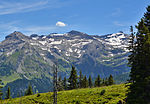Rawil Pass
Bern–Valais borderCanton of Bern geography stubsMountain passes of SwitzerlandMountain passes of ValaisMountain passes of the Alps ... and 2 more
Mountain passes of the canton of BernValais geography stubs
The Rawil Pass (el. 2429 m.) (German: Rawilpass) is a high mountain pass across the western Bernese Alps, connecting Lenk in the canton of Berne in Switzerland and Anzère or Crans Montana in the canton of Valais. The pass lies between the Wildhorn on the west and the Wildstrubel on the east. Lac de Tseuzier is located south of the pass.
Excerpt from the Wikipedia article Rawil Pass (License: CC BY-SA 3.0, Authors).Rawil Pass
Iffigenstrasse,
Geographical coordinates (GPS) Address Nearby Places Show on map
Geographical coordinates (GPS)
| Latitude | Longitude |
|---|---|
| N 46.383333333333 ° | E 7.4416666666667 ° |
Address
Iffigenstrasse
3775
Bern, Switzerland
Open on Google Maps








